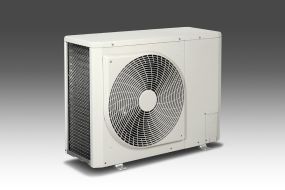Understanding the Differences Between AC Cleaning and HVAC Cleaning
In a typical business or home, there is either an HVAC or AC system, and sometimes both have been installed. While the terms are often used interchangeably, AC and HVAC systems perform different functions. Because of this, they require different maintenance procedures, making it important to know the difference between the systems before calling a technician for HVAC cleaning.
AC Systems
AC, or air conditioning systems, can come in two different forms: window or portable units and central AC. Both fulfill the same purpose, but on a different scale. Window and portable units are smaller air conditioners that are placed in an open window or on the floor to cool a single room. Central AC units connect to the ventilation system of a building to spread cool air through every room.
In order to cool an area, air conditioners suck in air from the space and pass it over a refrigerant cooled condenser coil. The heat and humidity in the air are attracted to the coil and absorbed by the refrigerant, effectively lowering the temperature of the air. Once this is accomplished, the cooled air is blown into the desired location. The heated refrigerant then flows into an evaporator coil, turning it to gas and allowing the heat energy to be expelled into the outdoors. Free from the heat, the refrigerant is condensed and cycled back into the AC unit, allowing the process to be repeated. The changing state of the refrigerant allows it to absorb and release heat when needed.
HVAC Systems
An HVAC system fulfills all the heating, venting and air conditioning needs of a building. The ducts and blower are large portions of the HVAC system and they work with various other units to provide both heating and air conditioning. HVAC systems typically include an air conditioner and a heater but can also work in conjunction with other systems. For large buildings, separate AC units may be installed to ensure the entire structure receives the proper amount of air flow.
Depending on the climate, an HVAC system may have its own heat source, circulate heat from another source or balance the temperature between areas by transferring heat. In cooler climates, where heat is not available outdoors to be transferred into a building, it is necessary for an electric or natural gas furnace to work with an HVAC system and supply the heat to be transferred. The many working parts of an HVAC system, as well as its extensive ventilation networks make HVAC cleaning a much more complex process than that of an AC system.
AC Cleaning Processes
While it’s best to call a technician to clean your AC system, especially for larger units, there are steps a homeowner or business can take to reduce the amount of wear and tear on a machine. On most AC units, there is an access panel that makes it easy to reach the working parts of the unit. To avoid injury, all cleaning procedures should be carried out after the unit has been turned off.
With a soft brush or cloth, the coils of the unit can be dusted off and wiped down to improve efficiency. The proper cleaning solutions can often be found at a hardware store to ensure a thorough clean. It’s also important to clean out the drain pan, as if left full of liquid it provides an excellent place for algae to grow.
To keep dirt and debris from getting stuck in an AC unit, it’s important to keep the area around it clean as well. This can include frequent raking or sweeping as well as a quick wipe down of the outside of the unit. It’s also important to keep the unit level, so the refrigerant can move freely and evenly throughout the system. By doing this, as well as more thorough cleans by a trained technician, an AC unit can maintain top efficiency and have a longer running life.
HVAC Cleaning Processes
HVAC cleaning requires a lengthier process than that of an AC unit, which is best carried out by a trained technician. Regular maintenance, such as changing the filters and keeping the surrounding area free of debris and dust help keep the system clean but cannot replace the work done by experienced workers.
When carrying out HVAC cleaning, technicians will perform an in-depth cleaning of the HVAC unit, separating the individual systems and cleaning away all debris and dust. During this stage, the technicians will also complete a maintenance check of all the functional portions of the system to ensure they will continue to serve the building reliably.
Trained technicians will also complete a thorough clean of the ventilation shafts in a building. This is typically done with electric brushes or whips to dislodge any dust from the shafts. Negative air pressure is created in the system to ensure the dislodged debris will not fall through any vents but will be sucked completely out of the system.
AC and HVAC systems are the regulators of temperature in many buildings. Though they seem to perform similar functions, they are quite different in the variety of tasks they can accomplish. Along with their different abilities, HVAC cleaning is more intensive than AC cleaning. When looking to install one or the other, it’s important to consider the desired service of the system to ensure the correct unit is installed.

 April 7th, 2022
April 7th, 2022  Arnold
Arnold 
 Posted in
Posted in 